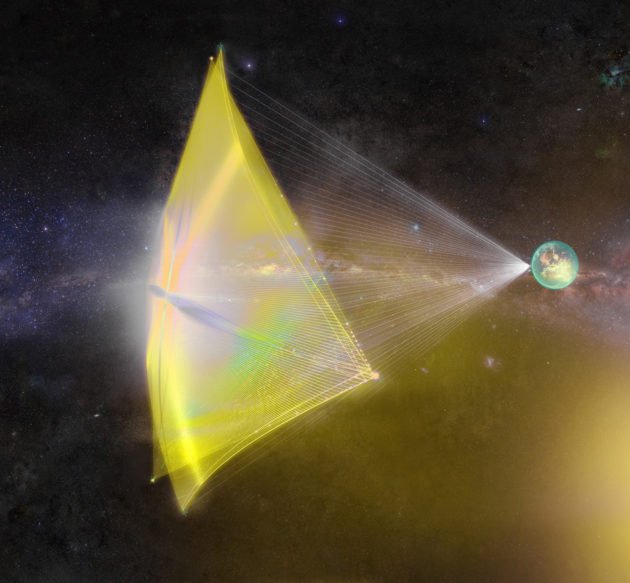

The scientists behind the Breakthrough Starshot mission are already fine-tuning the design for their nano-probes to increase the odds they’ll survive the trip to Proxima Centauri b.
In a paper posted to the arXiv pre-print server last week, researchers lay out their latest calculations on the kinds of damage their scaled-down spacecraft could face as they speed toward the Alpha Centauri system at 20 percent of the speed of light.
The mission and the study have taken on greater importance, due to this week’s announcement that a potentially habitable planet has been detected in orbit around Proxima Centauri, a red dwarf that’s part of the star system. It’s the star that’s closest to our own solar system, lying only 4.2 light-years away.
In astronomical terms, Proxima Centauri is right next door. But in mission planning terms, it’s far, far away. It would take tens of thousands of years for a conventional spacecraft to get there.
To reduce that time frame, Breakthrough Starshot has proposed sending bunches of lightweight electronic wafers, known as “Starchips.” The Starchips would be accelerated to relativistic speeds by aiming powerful lasers at film-thin light sails that carry the probes along.
If the system works as the team hopes, the nano-probes could zoom through the Alpha Centauri system and beam back data roughly 20 years after they’re launched.
That’s a big “if.” Loads of engineering challenges will have to be solved first. But Russian billionaire Yuri Milner’s initial contribution of $100 million to the effort has gotten things going, and this month’s paper addresses some of the challenges.
The researchers behind the paper include Harvard astrophysicist Avi Loeb, who chairs Breakthrough Starshot’s advisory committee. Loeb and his colleagues say that shielding the nano-probes from interstellar particles of gas and dust will be a “critical challenge for the initiative.”
Based on computer modeling, they say a grain of dust traveling at relativistic speeds could blast a crater in the surface of the spacecraft, and the heat of impact could melt or scramble additional bits of the material. Hitting heavy atoms of interstellar gas could be just as bad.
Fortunately, dust grains big enough to destroy the spacecraft completely are thought to be rare in the interstellar medium. “Their effect is likely to be unimportant,” the researchers say. But to minimize the damage from dust and gas bombardment, the researchers recommend putting a thin graphite shield in front of the spacecraft.
They also recommend configuring the Starchips to look like needles, pointing in the direction of travel. That would minimize the exposure of the probes’ electronics to the particle blast.
When the Breakthrough Starshot initiative was announced in April, Loeb and other advisers said it might take 20 years and billions of dollars to create the fleets of Starchips and light sails required for the mission, plus the battery of laser-equipped antennas to power them.
Assuming that the technology works, it’d take another 20 years or more for the trip, plus more than four years to hear back from the Alpha Centauri fly-by. Which means that under the most optimistic scenario, the payoff from the mission wouldn’t come until around 2060.
And we’re just talking about needle-sized probes here: This week, Science News’ Tom Siegfried noted that a conventional spacecraft propelled by chemical rocket technology would take almost 80,000 years to reach Proxima Centauri. Solar sail propulsion wouldn’t do that much better.
An experimental scheme known as near-light-speed particle propulsion, or NcPP, could cut that time to 4,000 to 9,000 years – but that’s still a mind-bogglingly long time.
“Surely within 4,000 years somebody will invent a faster technology that could pass the alpha-decay craft and get to Proxima b first,” Siegfried writes.
Let’s just hope Zefram Cochrane gets that warp drive invented in time to attract notice from the Vulcans in 2063, as described in “Star Trek: First Contact.”
[Source:-Geek Wire]





